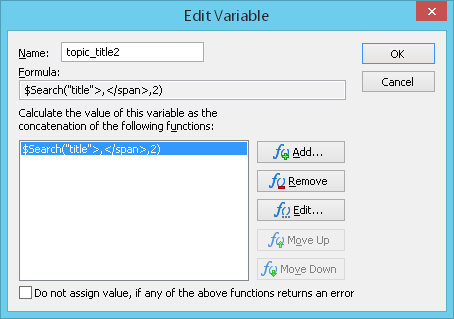Working with Session Variables
Dynamic data on HTML pages is usually represented in the form of:
![]() part of URL path that changes each time you
access a web page, or
part of URL path that changes each time you
access a web page, or
![]() a field (sometimes hidden) recorded during a
form submission.
a field (sometimes hidden) recorded during a
form submission.
Below are 2 typical examples of using the dynamic data on HTML pages.
Example 1.
Suppose you need to automate a simple scenario of navigating through a certain
site using respective HTTP requests:
- User registration:
http://myserver/register?User=Alex&Pass=qwerty
- After registration, the user is redirected to the
main category which displays links to all resources of the site.
At this stage, the SessionID
session variable is generated. The user selects the Main category
by clicking the respective link:
http://myserver/view?SessionID=FCHHAB02DF&Category=main
- The user selects a link to a particular resource:
http://myserver/view?SessionID=FCHHAB02DF&Category=main&Item=67
Example 2.
When some user submits a form on your site, a unique number is sent to the server together with all information entered by the user. The number is kept in a hidden field of HTML code. It will be different in a new browser session. When you run the test, web server will be unable to recognize that number.
These problems are successfully resolved in WAPT Pro by the usage of variables in recorded test scenario. In both examples, you can define variables and replace the dynamic data with them.
There are two main methods of incorporating the session variables into site pages:
- To incorporate session variables into URL path;
- To use a request parameter to transmit a session variable.
- Using functions URL from Form and URL from link;
- Using functions Hidden and Parameter from URL.
Note that functions like Parameter from URL or Hidden which obtain values from the actual server response are calculated using the following as an input:
How to define a formula for calculation of variable
You can use variables to calculate parameters and URL paths.
To define a variable, you can use functions that parse the actual HTML code of response at run-time.
The list of variables is displayed on the Response processing tab of request properties:
![]() Add..:
Opens the Edit Variable dialog where you can
create a new variable and select a function for its calculation.
Note that created variable will be available only in subsequent
requests.
Add..:
Opens the Edit Variable dialog where you can
create a new variable and select a function for its calculation.
Note that created variable will be available only in subsequent
requests.
![]() Remove:
Removes selected variable from the list.
Remove:
Removes selected variable from the list.
![]() Edit..:
Opens the Edit Variable dialog
where you can edit variable name and the function for its calculation.
Edit..:
Opens the Edit Variable dialog
where you can edit variable name and the function for its calculation.
 Name: Here you can change variable name.
Name: Here you can change variable name.
Formula: Here you can view the defined formula for calculation of the current variable.
This field is accessible only for viewing.
Functions: The list of functions for calculation of the current variable is displayed in this field.
You can define several functions for the same variable.
Results of those functions will be concatenated to form more complicated values.
![]() Add..:
Opens the Edit Function dialog where you can select a function
for calculation of the current variable.
Add..:
Opens the Edit Function dialog where you can select a function
for calculation of the current variable.
![]() Remove:
Removes selected function from the list. (That function will be deleted only from the list
of functions for calculation of the current variable.)
Remove:
Removes selected function from the list. (That function will be deleted only from the list
of functions for calculation of the current variable.)
![]() Edit..:
Opens the Edit Function dialog
where you can edit selected function or choose another function.
Edit..:
Opens the Edit Function dialog
where you can edit selected function or choose another function.
![]() Move Up:
Moves selected function one step up in the list (if you defined several functions for the same variable).
Move Up:
Moves selected function one step up in the list (if you defined several functions for the same variable).
![]() Move Down:
Moves selected function one step down in the list.
Move Down:
Moves selected function one step down in the list.
Do not assign value, if any of the above functions returns an error:
This option allows to keep an old value of variable if any of the displayed functions returns an error.
In this case the value of variable is not changed.
It is useful when variable is calculated as the concatenation of several functions (and some of them returns an error), or if
variable is calculated in a cycle (and its value changes with each iteration), or if variable is calculated several times in profile in different
requests.
Here you can read the detailed description of WAPT Pro functions that
can be used for calculation of the values of session
variables to form the correct URL during run-time.
